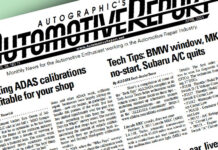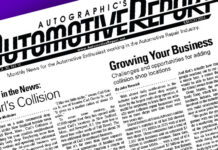OEMs boost tools, training and information they offer the collision repair industry
By John Yoswick
The collision repair industry for decades got very little attention from the automakers. Throughout the 1970s, 1980s and much of the 1990s, an estimated 12,000 dealership body shops closed, and while automakers varied in how much they produced in terms repair information for body shops, it generally was focused around only a few of their more unusual vehicle models or technology.
But automakers have re-engaged in collision repair in a big way, creating more repair information and finding new ways to make it more accessible. About two dozen automakers have launched body shop certification programs, most open to independent shops as well as dealer-owned. They are working with collision repair organizations to communicate — and in some cases legislate — the need for following OEM procedures.
Here’s a look at some of the ways automakers are working to help collision repairers.
Honda offers two subscription choices
Scott Kaboos, chief collision repair instructor for American Honda, said he was recently in a shop and was pleased to see they had printed out 26 pages of Honda’s procedures related to replacing a quarter panel. But what was missing, he said, were the additional procedures for all the related operations: removing the suspension and gas tank, removing the taillight, and even something as seemingly simple as disconnecting the battery.
“When you read that procedure, you realize this car has a steering angle sensor that has to be reset every time you disconnect the battery,” Kaboos said at the Society of Collision Repair Specialists’ “OEM Collision Repair Technology Summit” in Las Vegas last November. “If you didn’t look up the battery procedure, you may not know that.”
Kaboos said two different subscription types are available for the technical information website (https://techinfo.honda.com) for Honda and Acura repair vehicles. “Service Express” is just $10 a day ($350 for an annual subscription) and includes all the OEM repair procedures. For additional features, like greater search capabilities and scan tool integration, a “Service Information System” (SIS) subscription is $20 a day or $1,000 a year. (It is provided at no charge to Honda’s “ProFirst” certified body shops.)
The stepped-up subscription also includes a hotline subscribers can call if they are unable to locate information they need. Kaboos said those without an SIS subscription who cannot locate needed information can contact “Ask I-CAR” (if they are a Gold Class shop) or VeriFacts Automotive (if they are a VeriFacts Medallion shop).
Like other automaker representatives, Kaboos said shops concerned about whether Honda repair procedures are “recommended” or “required” should rely on the actual procedures rather than automaker position statements.
“The position statement is just to guide you to the repair information,” Kaboos said. “If you pull up our service information, it doesn’t say ‘require’ or ‘recommend.’ It is just our repair procedures, simply how we designed the car to be repaired if it is in a collision. If you’re using just the position statement, you may get into that semantic argument with an insurance company. If you’re using the actual repair procedures, that’s no longer part of the conversation.”
Kaboos pointed to a number of other resources Honda offers. One of the company’s websites (https://www.hondatechtutor.com/) aimed at owners of its vehicles offers model-specific videos that can help drivers or technicians understand how lane-keep assist and other such systems operate.
“This is a cool resource that even I didn’t know about until just a few months ago,” Kaboos said. “If a customer picks up a vehicle from you and says, ‘Something’s not the same, something’s working differently,’ you can go on here and see how that system is supposed to work, and work with the customer to get that car back to the settings that they had before, so it functions the same way.”
At another Honda owners’ website (https://owners.honda.com/), shops can download vehicle owner’s manuals or check vehicle recall information (it also includes a shop locator for Honda’s 1,350 ProFirst certified body shops). A website (https://profirstinfo.honda.com/) with information about that certified shop program includes consumer education videos that any shop — certified or not — can use.
Kaboos also said Honda is completing work on a collision repair training center in Chicago where it will offer hands-on classes.
Working with Toyota blind-spot monitors
Also speaking at the same SCRS event, Eric Mendoza, collision operations manager for Toyota Motor North America, said the company welcomes input about missing or unclear information in its technical information website (https://techinfo.toyota.com). Users can click a symbol (with a green “+” sign) in the upper right corner of each page of the site to submit feedback.
He cited an example of a question submitted by a shop relative to positioning a bracket for a blind-spot monitor.
“On some of our quarter panels, you order the panel and the bracket comes attached to it,” Mendoza said. “On some of them, you order the panel and the bracket does not come attached. You have to get the bracket separately and weld it in place. Originally when those two parts started to come out separately, we didn’t have a specification in the repair manual to show the location for the bracket. This is an example where user feedback turned into specifications within the repair manual.”
Mike Anderson of Collision Advice said shops are not always aware that Toyota procedures often call for removal of the blind-spot monitor for quarter panel replacement.
“To reinstall it, you must do an angle installation inspection,” Anderson said. “It requires you to use a tool, like a digital gauge, to make sure that blind spot monitor is at the right angle. This is supposed to be done before the vehicle is painted.”
The tool is available through Toyota’s “Service-Solutions” website (https://toyota.service-solutions.com).
“If you’re repairing Toyotas with blind-spot monitors, you absolutely need this tool,” Anderson said.
Automakers have post-crash safety inspection steps
Subaru is among the automakers reminding shops to check OEM procedures for necessary safety inspection steps required as part of collision repair work. The procedures can potentially require 15 to 20 labor hours, inspecting wiring and connectors, removing and measuring the steering column, checking seat belt anchors, etc.
Nicole Riedel of Subaru of America reiterated the automaker’s stance that the post-repair safety inspections called for in its repair procedures must be conducted following any repair of a Subaru.
“Every time,” Riedel emphasized. “Even if you are in New York City and vehicles are just getting sideview mirrors clipped, you still have to do it [after those repairs]. We will not deviate from that procedure. We are having conversations with Japan to review that. But at this time, we need you to do it every single time.”
Mark Olson of VECO Experts said Subaru is not alone in calling for such physical safety inspections after a collision.
“This is General Motors, Fiat Chrysler. This is all cars,” Olson said.
He said he is aware of three lawsuits involving shops’ failure to conduct such inspections.
“You’re not going to hear about them, because they’re going to settle out of court,” Olson said. “Those checklists are what the attorney is going to look at and say, ‘Did you do this, this and this?’ On some models, you have to R&I the headliner and the airbag, which is not reusable, so you actually have to deploy the airbag and replace it simply as part of the inspection.”
Subaru’s Riedel said in addition to Subaru’s technical information system (https://techinfo.subaru.com), shops may find the Subaru owners’ website (https://www.subaru.com/owners/index.html) useful for accessing vehicle owner’s manuals, as well as its “Service Solutions” website (https://subaru.service-solutions.com) for accessing Subaru-specific tools.
Shop feedback prompts OEM procedure
Having trouble finding the Fiat Chrysler repair information you need through the automaker’s TechAuthority system (https://www.techauthority.com/)? FCA’s Dan Black said the system’s search feature is pretty robust, but like Kaboos, he said stymied subscribers can contact “Ask I-CAR” (if they are a Gold Class shop) or can email him directly (customerservice@moparrepairconnection.com). He said TechAuthority also has a “Feedback” button on each page that can be used if information appears to be missing.
“What’s essential about the feedback button is to click it on the page where you are having the issue,” Black said. “So if you have a question about a body side replacement, click ‘Feedback’ on that pertinent page. Because if you click it on, say, a control arm page, it will be directed to a different individual who specializes in chassis, not necessarily collision repair.”
He pointed to an example of how shop feedback resulted in a change for a repair procedure for the 2017 Chrysler Pacifica. A shop asked about welding required in an area adjacent to an inaccessible cavity containing foam that must be removed before the welding process.
“We went back to our engineering team and developed a process for cutting a one-inch window in an area of high-strength steel to get a wand in there and extract the foam so it’s not in the weld zone area,” Black said.
He said FCA-certified body shops get one year of free access to TechAuthority, then pay $300 a year after that, compared to $1,800 per year that non-certified shops must pay for a subscription.
Other FCA websites that he said collision shops might find helpful are Mopar Essential Tools (https://www.moparessentialtools.com/), where shops can order FCA-specific tools, such as those needed to support ADAS features; Mopar.com, where vehicle owners’ manuals are available (just as they are through TechAuthority); and Mopar Repair Connection (https://www.moparrepairconnect.com/), which includes videos and documents highlighting (for shops or consumers) some of the potential distinctions between FCA parts and non-OEM versions, such as corrosion resistance and dimensional differences. •
John Yoswick, a freelance writer based in Portland, Ore., who has been writing about the automotive industry since 1988, is also the editor of the weekly CRASH Network bulletin (www.CrashNetwork.com). He can be contacted by email at john@CrashNetwork.com.



